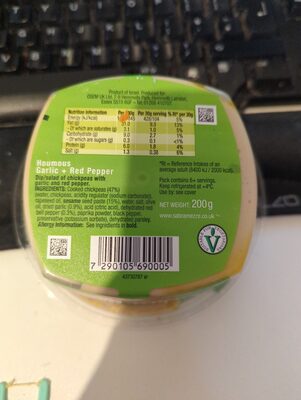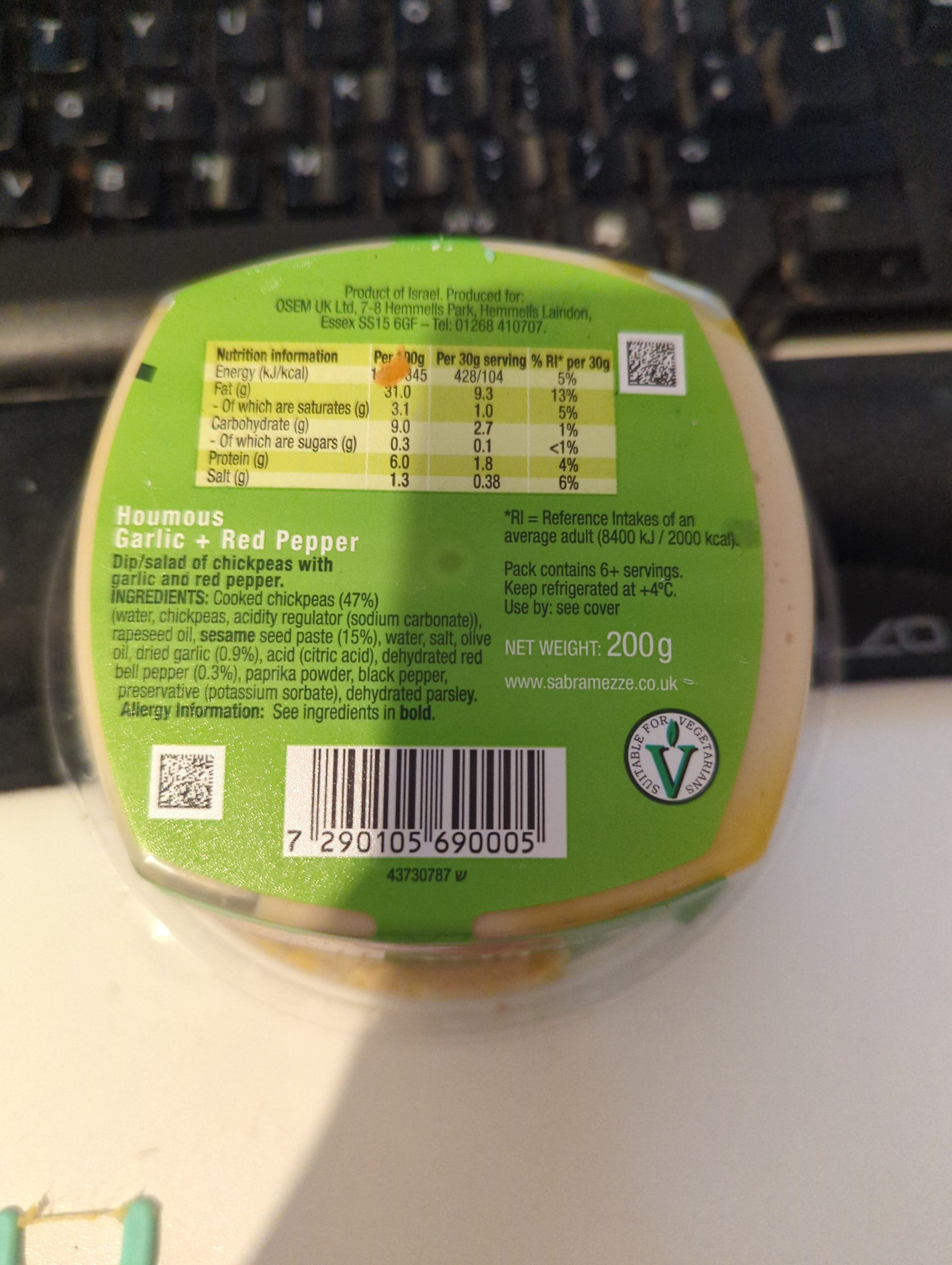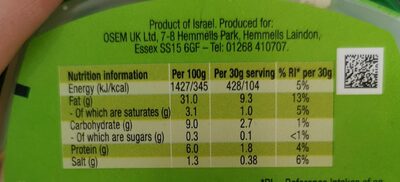Help us make food transparency the norm!
As a non-profit organization, we depend on your donations to continue informing consumers around the world about what they eat.
The food revolution starts with you!
Hummus Garlic + Red Pepper - Sabra - 200 g
Hummus Garlic + Red Pepper - Sabra - 200 g
This product page is not complete. You can help to complete it by editing it and adding more data from the photos we have, or by taking more photos using the app for Android or iPhone/iPad. Thank you!
×
Barcode: 7290105690005 (EAN / EAN-13)
Quantity: 200 g
Packaging: Pp-tub
Brands: Sabra
Categories: Plant-based foods and beverages, Plant-based foods, Condiments, Spreads, Plant-based spreads, Salted spreads, Sauces, Dips, Hummus
Countries where sold: United Kingdom
Matching with your preferences
Health
Ingredients
-
19 ingredients
Cooked chickpeas (47%) (water, chickpeas, acidity regulator (sodium carbonate)), rapeseed oil, sesame seed paste (15%), water, salt, olive oil, dried garlic (0.9%), acid (citric acid), dehydrated red bell pepper (0.3%), paprika powder, black pepper, preservative (potassium sorbate), dehydrated parsley.Allergens: Sesame seeds
Food processing
-
Processed foods
Elements that indicate the product is in the 3 - Processed foods group:
- Additive: E202 - Potassium sorbate
- Ingredient: Preservative
- Ingredient: Salt
- Ingredient: Vegetable oil
Food products are classified into 4 groups according to their degree of processing:
- Unprocessed or minimally processed foods
- Processed culinary ingredients
- Processed foods
- Ultra processed foods
The determination of the group is based on the category of the product and on the ingredients it contains.
Additives
-
E202 - Potassium sorbate
Potassium sorbate (E202) is a synthetic food preservative commonly used to extend the shelf life of various food products.
It works by inhibiting the growth of molds, yeast, and some bacteria, preventing spoilage. When added to foods, it helps maintain their freshness and quality.
Some studies have shown that when combined with nitrites, potassium sorbate have genotoxic activity in vitro. However, potassium sorbate is generally recognized as safe (GRAS) by regulatory authorities.
-
E330 - Citric acid
Citric acid is a natural organic acid found in citrus fruits such as lemons, oranges, and limes.
It is widely used in the food industry as a flavor enhancer, acidulant, and preservative due to its tart and refreshing taste.
Citric acid is safe for consumption when used in moderation and is considered a generally recognized as safe (GRAS) food additive by regulatory agencies worldwide.
-
E500 - Sodium carbonates
Sodium carbonates (E500) are compounds commonly used in food preparation as leavening agents, helping baked goods rise by releasing carbon dioxide when they interact with acids.
Often found in baking soda, they regulate the pH of food, preventing it from becoming too acidic or too alkaline. In the culinary world, sodium carbonates can also enhance the texture and structure of foods, such as noodles, by modifying the gluten network.
Generally recognized as safe, sodium carbonates are non-toxic when consumed in typical amounts found in food.
-
E500i - Sodium carbonate
Sodium carbonate: Sodium carbonate, Na2CO3, -also known as washing soda, soda ash and soda crystals, and in the monohydrate form as crystal carbonate- is the water-soluble sodium salt of carbonic acid. It most commonly occurs as a crystalline decahydrate, which readily effloresces to form a white powder, the monohydrate. Pure sodium carbonate is a white, odorless powder that is hygroscopic -absorbs moisture from the air-. It has a strongly alkaline taste, and forms a moderately basic solution in water. Sodium carbonate is well known domestically for its everyday use as a water softener. Historically it was extracted from the ashes of plants growing in sodium-rich soils, such as vegetation from the Middle East, kelp from Scotland and seaweed from Spain. Because the ashes of these sodium-rich plants were noticeably different from ashes of timber -used to create potash-, they became known as "soda ash". It is synthetically produced in large quantities from salt -sodium chloride- and limestone by a method known as the Solvay process. The manufacture of glass is one of the most important uses of sodium carbonate. Sodium carbonate acts as a flux for silica, lowering the melting point of the mixture to something achievable without special materials. This "soda glass" is mildly water-soluble, so some calcium carbonate is added to the melt mixture to make the glass produced insoluble. This type of glass is known as soda lime glass: "soda" for the sodium carbonate and "lime" for the calcium carbonate. Soda lime glass has been the most common form of glass for centuries. Sodium carbonate is also used as a relatively strong base in various settings. For example, it is used as a pH regulator to maintain stable alkaline conditions necessary for the action of the majority of photographic film developing agents. It acts as an alkali because when dissolved in water, it dissociates into the weak acid: carbonic acid and the strong alkali: sodium hydroxide. This gives sodium carbonate in solution the ability to attack metals such as aluminium with the release of hydrogen gas.It is a common additive in swimming pools used to raise the pH which can be lowered by chlorine tablets and other additives which contain acids. In cooking, it is sometimes used in place of sodium hydroxide for lyeing, especially with German pretzels and lye rolls. These dishes are treated with a solution of an alkaline substance to change the pH of the surface of the food and improve browning. In taxidermy, sodium carbonate added to boiling water will remove flesh from the bones of animal carcasses for trophy mounting or educational display. In chemistry, it is often used as an electrolyte. Electrolytes are usually salt-based, and sodium carbonate acts as a very good conductor in the process of electrolysis. In addition, unlike chloride ions, which form chlorine gas, carbonate ions are not corrosive to the anodes. It is also used as a primary standard for acid-base titrations because it is solid and air-stable, making it easy to weigh accurately.Source: Wikipedia
Ingredients analysis
-
Palm oil free
No ingredients containing palm oil detected
-
Vegan
No non-vegan ingredients
-
Vegetarian
No non-vegetarian ingredients detected
-
Details of the analysis of the ingredients
en: Cooked chickpeas 47% (water, chickpeas, acidity regulator (sodium carbonate)), rapeseed oil, sesame seed paste 15%, water, salt, olive oil, dried garlic 0.9%, acid (citric acid), red bell pepper 0.3%, paprika powder, black pepper, preservative (potassium sorbate), parsley- Cooked chickpeas -> en:cooked-chickpeas - vegan: yes - vegetarian: yes - ciqual_food_code: 20507 - percent_min: 47 - percent: 47 - percent_max: 47
- water -> en:water - vegan: yes - vegetarian: yes - ciqual_food_code: 18066 - percent_min: 15.6666666666667 - percent_max: 47
- chickpeas -> en:chickpea - vegan: yes - vegetarian: yes - ciqual_food_code: 20532 - percent_min: 0 - percent_max: 23.5
- acidity regulator -> en:acidity-regulator - percent_min: 0 - percent_max: 15.6666666666667
- sodium carbonate -> en:e500i - vegan: yes - vegetarian: yes - percent_min: 0 - percent_max: 15.6666666666667
- rapeseed oil -> en:rapeseed-oil - vegan: yes - vegetarian: yes - from_palm_oil: no - percent_min: 17.1 - percent_max: 33.8
- sesame seed paste -> en:sesame-paste - vegan: yes - vegetarian: yes - ciqual_food_code: 15010 - percent_min: 15 - percent: 15 - percent_max: 15
- water -> en:water - vegan: yes - vegetarian: yes - ciqual_food_code: 18066 - percent_min: 0.9 - percent_max: 15
- salt -> en:salt - vegan: yes - vegetarian: yes - ciqual_food_code: 11058 - percent_min: 0.9 - percent_max: 1.3
- olive oil -> en:olive-oil - vegan: yes - vegetarian: yes - from_palm_oil: no - ciqual_proxy_food_code: 17270 - percent_min: 0.9 - percent_max: 1.3
- dried garlic -> en:dried-garlic - vegan: yes - vegetarian: yes - ciqual_food_code: 11023 - percent_min: 0.9 - percent: 0.9 - percent_max: 0.9
- acid -> en:acid - percent_min: 0.3 - percent_max: 0.9
- citric acid -> en:e330 - vegan: yes - vegetarian: yes - percent_min: 0.3 - percent_max: 0.9
- red bell pepper -> en:red-bell-pepper - vegan: yes - vegetarian: yes - ciqual_food_code: 20087 - percent_min: 0.3 - percent: 0.3 - percent_max: 0.3
- paprika powder -> en:paprika-powder - vegan: yes - vegetarian: yes - ciqual_food_code: 11049 - percent_min: 0 - percent_max: 0.3
- black pepper -> en:black-pepper - vegan: yes - vegetarian: yes - ciqual_food_code: 11015 - percent_min: 0 - percent_max: 0.3
- preservative -> en:preservative - percent_min: 0 - percent_max: 0.3
- potassium sorbate -> en:e202 - vegan: yes - vegetarian: yes - percent_min: 0 - percent_max: 0.3
- parsley -> en:parsley - vegan: yes - vegetarian: yes - ciqual_proxy_food_code: 11014 - percent_min: 0 - percent_max: 0.3
- Cooked chickpeas -> en:cooked-chickpeas - vegan: yes - vegetarian: yes - ciqual_food_code: 20507 - percent_min: 47 - percent: 47 - percent_max: 47
Nutrition
-
Average nutritional quality
⚠ ️Warning: the amount of fiber is not specified, their possible positive contribution to the grade could not be taken into account.⚠ ️Warning: the amount of fruits, vegetables and nuts is not specified on the label, it was estimated from the list of ingredients: 76This product is not considered a beverage for the calculation of the Nutri-Score.
Positive points: 2
- Proteins: 3 / 5 (value: 6, rounded value: 6)
- Fiber: 0 / 5 (value: 0, rounded value: 0)
- Fruits, vegetables, nuts, and colza/walnut/olive oils: 2 / 5 (value: 76.125, rounded value: 76.1)
Negative points: 12
- Energy: 4 / 10 (value: 1443, rounded value: 1443)
- Sugars: 0 / 10 (value: 3, rounded value: 3)
- Saturated fat: 3 / 10 (value: 3.1, rounded value: 3.1)
- Sodium: 5 / 10 (value: 520, rounded value: 520)
The points for proteins are not counted because the negative points are greater or equal to 11.
Nutritional score: (12 - 2)
Nutri-Score:
-
Nutrient levels
-
Fat in high quantity (31%)
What you need to know- A high consumption of fat, especially saturated fats, can raise cholesterol, which increases the risk of heart diseases.
Recommendation: Limit the consumption of fat and saturated fat- Choose products with lower fat and saturated fat content.
-
Saturated fat in moderate quantity (3.1%)
What you need to know- A high consumption of fat, especially saturated fats, can raise cholesterol, which increases the risk of heart diseases.
Recommendation: Limit the consumption of fat and saturated fat- Choose products with lower fat and saturated fat content.
-
Sugars in low quantity (3%)
What you need to know- A high consumption of sugar can cause weight gain and tooth decay. It also augments the risk of type 2 diabetes and cardio-vascular diseases.
Recommendation: Limit the consumption of sugar and sugary drinks- Sugary drinks (such as sodas, fruit beverages, and fruit juices and nectars) should be limited as much as possible (no more than 1 glass a day).
- Choose products with lower sugar content and reduce the consumption of products with added sugars.
-
Salt in moderate quantity (1.3%)
What you need to know- A high consumption of salt (or sodium) can cause raised blood pressure, which can increase the risk of heart disease and stroke.
- Many people who have high blood pressure do not know it, as there are often no symptoms.
- Most people consume too much salt (on average 9 to 12 grams per day), around twice the recommended maximum level of intake.
Recommendation: Limit the consumption of salt and salted food- Reduce the quantity of salt used when cooking, and don't salt again at the table.
- Limit the consumption of salty snacks and choose products with lower salt content.
-
-
Nutrition facts
Nutrition facts As sold
for 100 g / 100 mlCompared to: Hummus Energy 1,443 kj
(345 kcal)+40% Fat 31 g +70% Saturated fat 3.1 g +50% Carbohydrates 9 g -27% Sugars 3 g +78% Fiber ? Proteins 6 g -7% Salt 1.3 g +24% Fruits‚ vegetables‚ nuts and rapeseed‚ walnut and olive oils (estimate from ingredients list analysis) 76.125 %
Environment
-
Eco-Score B - Low environmental impact
⚠ ️Select a country in order to include the full impact of transportation.The Eco-Score is an experimental score that summarizes the environmental impacts of food products.→ The Eco-Score was initially developped for France and it is being extended to other European countries. The Eco-Score formula is subject to change as it is regularly improved to make it more precise and better suited to each country.Life cycle analysis
-
Average impact of products of the same category: A (Score: 92/100)
Category: Hummus
Category: Hummus
- PEF environmental score: 0.18 (the lower the score, the lower the impact)
- including impact on climate change: 0.95 kg CO2 eq/kg of product
Stage Impact Agriculture
51.0 %Processing
17.9 %Packaging
10.6 %Transportation
13.9 %Distribution
5.2 %Consumption
1.4 %
Bonuses and maluses
-
Missing origins of ingredients information
Malus: -5
⚠ ️ The origins of the ingredients of this product are not indicated.
If they are indicated on the packaging, you can modify the product sheet and add them.
If you are the manufacturer of this product, you can send us the information with our free platform for producers.
-
Packaging with a medium impact
Malus: -8
Shape Material Recycling Impact Unknown PP 5 - Polypropylene High ⚠ ️ The information about the packaging of this product is not sufficiently precise (exact shapes and materials of all components of the packaging).⚠ ️ For a more precise calculation of the Eco-Score, you can modify the product page and add them.
If you are the manufacturer of this product, you can send us the information with our free platform for producers.
Eco-Score for this product
-
Impact for this product: B (Score: 79/100)
Product: Hummus Garlic + Red Pepper - Sabra - 200 g
Life cycle analysis score: 92
Sum of bonuses and maluses: -13
Final score: 79/100
-
Carbon footprint
-
Equal to driving 0.5 km in a petrol car
95 g CO² per 100g of product
The carbon emission figure comes from ADEME's Agribalyse database, for the category: Hummus (Source: ADEME Agribalyse Database)
Stage Impact Agriculture
32.4 %Processing
16.5 %Packaging
17.9 %Transportation
28.6 %Distribution
3.9 %Consumption
0.7 %
Packaging
-
Packaging with a medium impact
-
Packaging parts
(PP 5 - Polypropylene)
-
Packaging materials
Material % Packaging weight Packaging weight per 100 g of product Plastic
-
Transportation
-
Origins of ingredients
Missing origins of ingredients information
⚠ ️ The origins of the ingredients of this product are not indicated.
If they are indicated on the packaging, you can modify the product sheet and add them.
If you are the manufacturer of this product, you can send us the information with our free platform for producers.Add the origins of ingredients for this product Add the origins of ingredients for this product
Report a problem
-
Incomplete or incorrect information?
Category, labels, ingredients, allergens, nutritional information, photos etc.
If the information does not match the information on the packaging, please complete or correct it. Open Food Facts is a collaborative database, and every contribution is useful for all.
Data sources
Product added on by kiliweb
Last edit of product page on by mikery.
Product page also edited by ecoscore-impact-estimator, inf, packbot, roboto-app, swipe-studio, teolemon, yuka.YlA0d0hJQTZwOXBTbmNRMDF4UHQ2NHBreloydWZGTHBNUGNKSVE9PQ.











